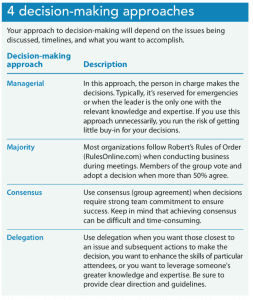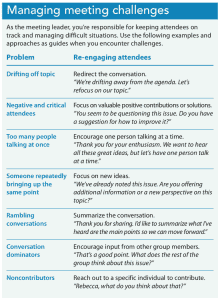Preparation and follow-up can keep meetings productive and on track.
Takeaways:
- Careful preparation can contribute to effective meetings.
- Consider group processes and use leadership approaches when conducting meetings.
As nurses move into formal and informal leadership roles and engage in shared decision-making, many will be expected to chair and run professional meetings. Unfortunately, being a skilled clinician doesn’t necessarily mean you’re prepared to lead meetings. That lack of preparation can be problematic, leading to unproductive, unfocused, and disorganized meetings that waste time. Ultimately, unsuccessful meetings result in dissatisfaction, disengagement, and poor outcomes. Fortunately, following a few simple steps before, during, and after meetings can help ensure they are meaningful, add value, and contribute positively to patient, nurse, and organizational outcomes.
Plan the meeting
The first step in planning an effective meeting is determining if it’s needed. Consider the purpose of the proposed meeting and what needs to be accomplished. Is a meeting the best approach? What specifically needs to happen during the meeting? Sometimes, you can find a better way to achieve goals. For example, if you’re communicating information, such as a simple policy update, consider disseminating it via the unit or organizational newsletter, posting announcements or fliers on the unit, discussing the change in morning huddles, or sharing the information in a group email.
Common reasons for holding a meeting are to brainstorm or generate ideas, solve a problem, make decisions, plan actions, and share complex information.
Who should attend?
If you determine a meeting is the best approach to achieve your goal, decide who needs to attend. You’ll want to include key stakeholders and anyone with specialized knowledge or expertise about the topic. You want all the right people to attend, but be careful not to invite too many. More than 12 people in a meeting can make it difficult to manage and may interfere with participation.
When and where will the meeting be held?
Next, choose a date, time, and location for your meeting. This can be challenging with professionals working opposite shifts on different days of the week. If possible, get feedback from attendees about what will work best. Use a computer app (such as Doodle, When2meet, or Calendly) to help determine participant availability and find the best meeting time for your group. You may need to hold the meeting just before or after shift change, or you may want to offer the meeting multiple times to accommodate everyone’s schedules. Offering the meeting more than once can help keep attendance lower at each meeting time, which can be helpful if many people need to attend.
Your meeting location should be convenient for all attendees. See what rooms or spaces are available. If meeting with professionals from multiple areas of the organization, consider using a neutral location versus your unit’s conference room.
Set and distribute the agenda
Your agenda should be a road map that identifies the purpose and structure of the meeting and serves as a useful preparation tool for you and the attendees. Consider what issues need to be addressed and a logical order for tackling them. Some experts suggest that items requiring the most discussion or priority topics should appear first on the agenda, while others advocate for beginning with routine items and then moving on to more contentious issues. Another approach is starting with items that unite the group. Assess your topics and attendees to determine the order that will work best for your meeting.


The agenda should look professional; if your organization has a standardized agenda template, use it. Include general meeting information (date, time, and location), and distribute the agenda at least a few days before the meeting.
Conduct the meeting
As the person conducting the meeting, you must facilitate the topics discussed, adhere to the time limits, and manage the people and processes. Arrive early and make sure the room is arranged so participants can see and hear each other. A horseshoe or circle seating arrangement encourages discussion. If possible, request that the room be set up the way you want it when you book your meeting space. Ensure any needed technology or other materials are ready before participants arrive, and assign someone to take notes during the meeting.
Start the meeting on time; don’t delay for late arrivals. Welcome attendees and thank them for their time. If participants don’t know each other, allow time for introductions. Some meetings will require attendance documentation, so use a sign-in sheet or orally confirm attendance. If you need a written record of the meeting, ask for a notetaking volunteer. You may want to assign this role ahead of time and decide whether the notetaker will type and distribute meeting minutes or if you’ll perform these tasks. Use your organization’s meeting minute templates, if available.
To help focus attention and provide a meeting preview, remind attendees of the agenda. You also may want to establish and/or remind attendees of meeting guidelines, such as the process for contributing to the discussion, voting procedures, technology use, confidentiality, and respect. Explain how decisions will be made during the meeting and make sure participants understand the selected approach. (See 4 decision-making approaches.)
In addition to your oversight, assign someone to monitor the time. However, as the meeting progresses, be flexible. Discussions don’t always proceed as predicted. If a topic takes longer than anticipated, you’ll have to decide whether to continue with that topic or suggest revisiting it later. Simple statements or questions can help. For example: “We’ve approached the end of the allotted time for this topic. Would the group like to continue for another 5 minutes or shall we conclude this discussion and move on to the next item?” This approach reminds attendees of time constraints and also allows them to offer input on how to proceed.
If a discussion veers off topic, you’ll need to help the group remain focused on the agenda 

Conclude the meeting with a summary of events and an action plan. Review next steps, who will perform action items, and when they’ll be completed. If you need to schedule another meeting with the group, do so while attendees are present so they can offer input into their availability. Finish the meeting on time and, if possible, close on a note of achievement or an expression of appreciation.
Meeting follow-up
After the meeting, distribute minutes or notes, which should summarize the topics, discussions, and outcomes. Seek review for clarity and accuracy. For example, ask participants to approve previous meeting minutes in subsequent meetings. Follow up on any action items and check with individual attendees and groups as needed before the next meeting. Finally, to improve your performance, reflect on the meeting and consider what went well and what you can work to improve. You also may want to share your thoughts with attendees and seek their input.
Be prepared
Many nurses move into leadership roles with little preparation on how to conduct an effective meeting. To ensure your meetings are meaningful, successful, and efficient, identify the reason for the meeting, develop and distribute an agenda, and engage attendees in discussions and decision-making.
The authors work at Indiana University of Pennsylvania in Indiana, Pennsylvania. Teresa Shellenbarger is a distinguished university professor and the doctoral program coordinator. Jennifer Chicca is a doctoral (PhD) candidate and graduate assistant.
References
Cryts A. Eight tips for running more effective meetings. Manag Healthc Exec. September 2, 2018. managedhealthcareexecutive.com/slideshows/eight-tips-running-more-effective-meetings
Mroz JE, Allen JA, Verhoeven DC, Shuffler ML. Do we really need another meeting? The science of workplace meetings. Curr Dir Psychol Sci. 2018;27(6):484-91.
Neville K, Re S. Guidelines for creating meaningful meeting minutes. Teach Learn Nurs. 2019;14(4):235-7.


















